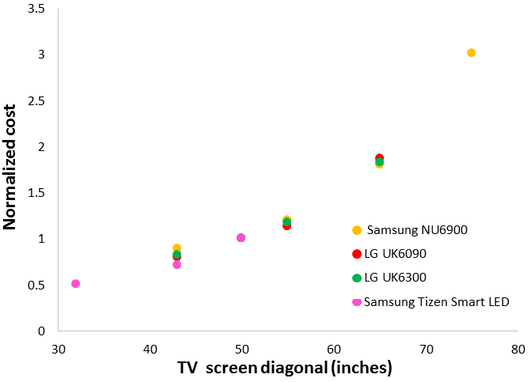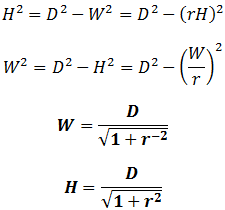To collect data for this investigation, I consulted The TV section of Walmart’s Canadian website. Here I found 138 TVs listed with screen diagonals ranging from 19” to 75”. I recorded the size and cost of each, summarized in the graph below.
To tease out the relationship between TV size and price, we must compare TVs which are identical in every way except size. Fortunately, it is possible to do this: some companies sell series of TV models which offer the same features at multiple screen sizes. Although this greatly limits the data available, it does conveniently remove the confounding factors. I selected four TV series: two by Samsung (NU6900 and Tizen Smart LED) and two by LG (UK6090 and UK6300).
Calculating TV screen area from diagonal length
TV cost is proportional to screen area
Having established the relationship between TV screen area and cost using controlled data, we can return to the total data set to gain more insights about TV prices. There was a large range of prices at each TV size, mostly due to the presence or absence of various features in the different models. If the availability of such features is fairly equal across TV sizes, averaging the prices at each size may largely cancel out this variability. I tried this, and it afforded a surprisingly strong linear correlation with screen area.
Conclusion
The fairness of these prices may come as a surprise to many consumers, since each additional increase in diagonal length appears progressively more expensive. I have shown that this is merely a consequence of the relationship between diagonal length and area. Though geometrically straightforward, some consumers may not have considered this point. It is unfortunate that screen area is not widely used for comparing TV sizes. In addition to being more intuitive, it also simplifies comparing TVs of different aspect ratios. Though most modern TVs have a 16:9 aspect ratio, older TVs usually had a 4:3 ratio. In such cases comparison of diagonal lengths is particularly misleading.












 RSS Feed
RSS Feed